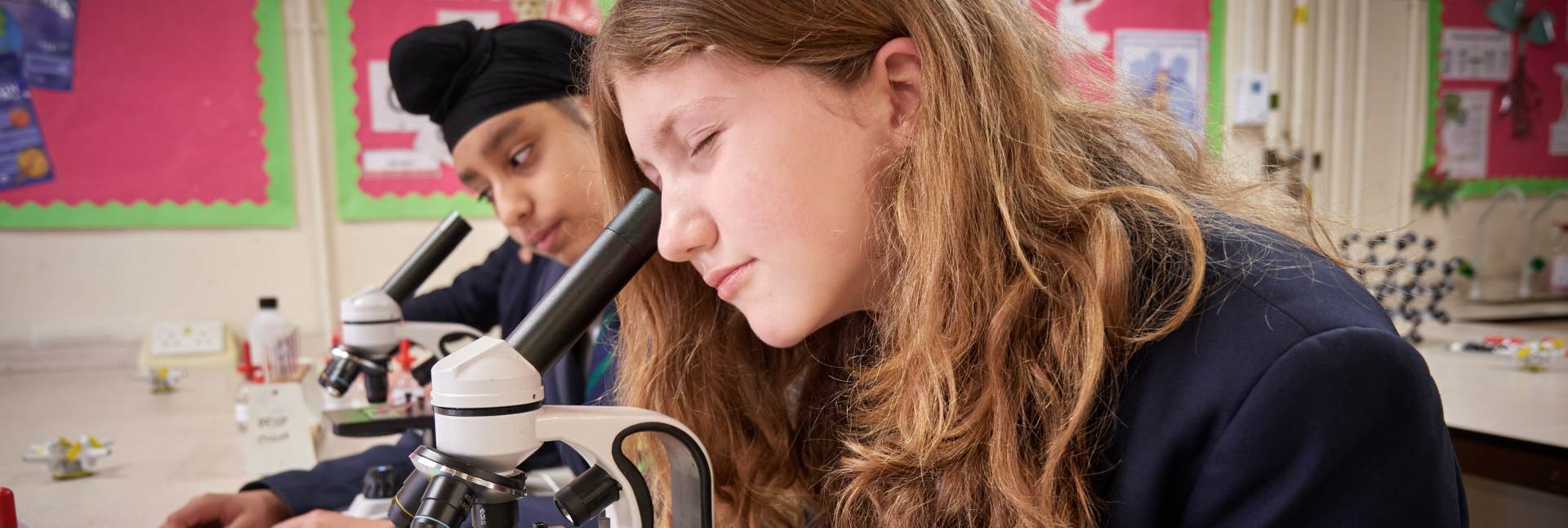Science
Intent:
The Sandhurst School Science Department is dedicated to fostering a generation of enthusiastic, confident, and critically-thinking scientists who are equipped to tackle the challenges of the future. We believe that science is for everyone, and we strive to provide all students with the opportunity to develop a deep understanding of the world around them through engaging and stimulating learning experiences.
Further information:
Our curriculum:
Our ambitious curriculum is designed to ignite a passion for science and encourage lifelong curiosity about the natural world. We aim to equip students with a strong foundation in scientific knowledge and skills across biology, chemistry, and physics. Students will develop critical thinking, problem-solving, and analytical abilities through inquiry-based learning and practical investigations. Effective communication skills will be fostered through scientific writing, presentations, and discussion. Collaboration and teamwork within the scientific community will be promoted and an appreciation for the ethical and societal implications of science and its role in shaping the future cultivated.
Implementation: Teaching and planning:
We differentiate through tailored instruction to meet the diverse needs of all learners, including those with SEN/D, EAL, and other identified groups. Literacy and oracy are integrated into our curriculum, fostering effective communication skills essential for scientific success.
Students are provided with opportunities to explore and discuss career paths as part of lessons, with teachers employing their own previous career experiences to enrich the learning experience. We expose students to diverse scientific contributions from various cultures and backgrounds, growing a broader understanding of the world and challenging stereotypes in science. We integrate the school's core values of respect, ambition, resilience, and pride into our lessons, fostering responsible and well-rounded individuals.
Assessment:
Progress is monitored using a variety of assessment strategies allowing areas of improvement to be identified, and targeted feedback given.
Impact:
By implementing these strategies, the Sandhurst School Science Department aims to empower our students to become confident and responsible citizens who are equipped to contribute positively to the world through their scientific knowledge and understanding.

Curriculum time allocation
KS3 (Years 7, 8 and 9) - 6 hours per fortnight
KS4 (Years 10 and 11) - 10 hours per fortnight / 15 hours for Triple Science
Homework policy
Curriculum pathways
KS4 Personal Learning Checklists (PLC)
Biology
Biology - Unit B1 Cell Structure & Transport
Biology - Unit B2 Cell Division
Biology - Unit B3 Organisation and the Digestive System
Biology - Unit B4 Organising Animals and Plants
Biology - Unit B5 Communicable Disease
Biology - Unit B6 Preventing & Treating Disease
Biology - Unit B7 Non-Communicable Diseases
Biology - Unit B8 Photosynthesis
Biology - Unit B10 The Human Nervous System
Biology - Unit B11 Hormonal Coordination
Biology - Unit B12 Homeostasis in Action
Biology - Unit B13 Reproduction
Biology - Unit B14 Variation and Evolution
Biology - Unit B15 Genetics and Evolution
Biology - Unit B16 Adaptations, Interdependence and Competition
Biology - Unit B17 Organising an Ecosystem
Biology - Unit B18 Biodiversity and Ecosystems
Chemistry
Chemistry - Unit C1 Atomic Structure
Chemistry - Unit C2 The Periodic Table
Chemistry - Unit C3 Structure and Bonding
Chemistry - Unit C4 Chemical Calculations
Chemistry - Unit C5 Chemical Changes
Chemistry - Unit C6 Electrolysis
Chemistry - Unit C7 Energy Changes
Chemistry - Unit C8 Rates and Equilibrium
Chemistry - Unit C9 Crude Oil and Fuels
Chemistry - Unit C10 Organic Reactions (Triple only)
Chemistry - Unit C11 Polymers (Triple only)
Chemistry - Unit C12 Chemical Analysis
Chemistry - Unit C13 The Earth's Atmosphere
Chemistry - Unit C14 Using Resources
Chemistry - Unit C15 Using our Resources (Triple only)
Physics
Physics - Unit P1 Conservation and Dissipation of Energy
Physics - Unit P2 Energy Transfer By Heating
Physics - Unit P3 Energy Demands
Physics - Unit P4 Electric Circuits
Physics - Unit P5 Electricity In The Home
Physics - Unit P6 Molecules and Matter
Physics - Unit P7 Radioactivity
Physics - Unit P8 Forces in Balance
Physics - Unit P10 Force and Motion
Physics - Unit P11 Force and Pressure (Triple only)
Physics - Unit P12 Wave Properties
Physics - Unit P13 Electromagnetic Waves
Physics - Unit P14 Light (Triple only)
Physics - Unit P15 Electromagnetism
Physics - Unit P16 Space (Triple only)
KS4 exam information
| Exam | Combined Science Biology Trilogy |
| Board | AQA |
| Spec | 8464 |
| Paper 1 |
75 Minutes Content: Kerboodle reference codes
|
| Paper 2 |
75 Minutes Content:Kerboodle reference codes
|
| Exam | Combined Science Chemistry Trilogy |
| Board | AQA |
| Spec | 8464 |
| Paper 1 |
75 Minutes Kerboodle Ref:
|
| Paper 2 |
75 Minutes Kerboodle Ref:
|
| Exam | Combined Science Physics Trilogy |
| Board | AQA |
| Spec | 8464 |
| Paper 1 |
75 Minutes Kerboodle Ref:
|
| Paper 2 |
75 Minutes Kerboodle ref:
|
| Exam | Biology |
| Board | AQA |
| Spec | 8461 |
| Paper 1 |
105 minutes Content Kerboodle ref:
|
| Paper 2 |
105 minutes
|
| Exam | Chemistry |
| Board | AQA |
| Spec | 8462 |
| Paper 1 |
105 minutes Kerboodle Ref:
|
| Paper 2 |
105 minutes Kerboodle ref:
|
| Exam | Physics |
| Board | AQA |
| Spec | 8463 |
| Paper 1 |
105 minutes Kerboodle ref:
|
| Paper 2 |
105 minutes Kerboodle ref:
|
Department Contact
Mr D Barrett
dbarrett@sandhurstschool.org.uk

